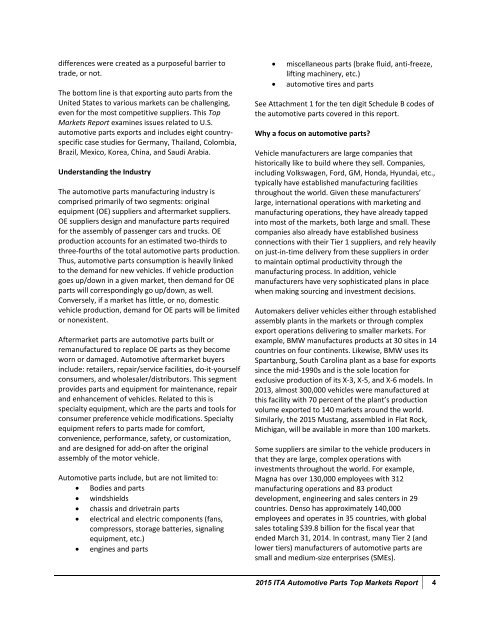Automotive Parts
Autoparts_Top_Markets_Report
Autoparts_Top_Markets_Report
Create successful ePaper yourself
Turn your PDF publications into a flip-book with our unique Google optimized e-Paper software.
differences were created as a purposeful barrier totrade, or not.The bottom line is that exporting auto parts from theUnited States to various markets can be challenging,even for the most competitive suppliers. This TopMarkets Report examines issues related to U.S.automotive parts exports and includes eight countryspecificcase studies for Germany, Thailand, Colombia,Brazil, Mexico, Korea, China, and Saudi Arabia.Understanding the IndustryThe automotive parts manufacturing industry iscomprised primarily of two segments: originalequipment (OE) suppliers and aftermarket suppliers.OE suppliers design and manufacture parts requiredfor the assembly of passenger cars and trucks. OEproduction accounts for an estimated two-thirds tothree-fourths of the total automotive parts production.Thus, automotive parts consumption is heavily linkedto the demand for new vehicles. If vehicle productiongoes up/down in a given market, then demand for OEparts will correspondingly go up/down, as well.Conversely, if a market has little, or no, domesticvehicle production, demand for OE parts will be limitedor nonexistent.Aftermarket parts are automotive parts built orremanufactured to replace OE parts as they becomeworn or damaged. <strong>Automotive</strong> aftermarket buyersinclude: retailers, repair/service facilities, do-it-yourselfconsumers, and wholesaler/distributors. This segmentprovides parts and equipment for maintenance, repairand enhancement of vehicles. Related to this isspecialty equipment, which are the parts and tools forconsumer preference vehicle modifications. Specialtyequipment refers to parts made for comfort,convenience, performance, safety, or customization,and are designed for add-on after the originalassembly of the motor vehicle.<strong>Automotive</strong> parts include, but are not limited to:• Bodies and parts• windshields• chassis and drivetrain parts• electrical and electric components (fans,compressors, storage batteries, signalingequipment, etc.)• engines and parts• miscellaneous parts (brake fluid, anti-freeze,lifting machinery, etc.)• automotive tires and partsSee Attachment 1 for the ten digit Schedule B codes ofthe automotive parts covered in this report.Why a focus on automotive parts?Vehicle manufacturers are large companies thathistorically like to build where they sell. Companies,including Volkswagen, Ford, GM, Honda, Hyundai, etc.,typically have established manufacturing facilitiesthroughout the world. Given these manufacturers’large, international operations with marketing andmanufacturing operations, they have already tappedinto most of the markets, both large and small. Thesecompanies also already have established businessconnections with their Tier 1 suppliers, and rely heavilyon just-in-time delivery from these suppliers in orderto maintain optimal productivity through themanufacturing process. In addition, vehiclemanufacturers have very sophisticated plans in placewhen making sourcing and investment decisions.Automakers deliver vehicles either through establishedassembly plants in the markets or through complexexport operations delivering to smaller markets. Forexample, BMW manufactures products at 30 sites in 14countries on four continents. Likewise, BMW uses itsSpartanburg, South Carolina plant as a base for exportssince the mid-1990s and is the sole location forexclusive production of its X-3, X-5, and X-6 models. In2013, almost 300,000 vehicles were manufactured atthis facility with 70 percent of the plant’s productionvolume exported to 140 markets around the world.Similarly, the 2015 Mustang, assembled in Flat Rock,Michigan, will be available in more than 100 markets.Some suppliers are similar to the vehicle producers inthat they are large, complex operations withinvestments throughout the world. For example,Magna has over 130,000 employees with 312manufacturing operations and 83 productdevelopment, engineering and sales centers in 29countries. Denso has approximately 140,000employees and operates in 35 countries, with globalsales totaling $39.8 billion for the fiscal year thatended March 31, 2014. In contrast, many Tier 2 (andlower tiers) manufacturers of automotive parts aresmall and medium-size enterprises (SMEs).2015 ITA <strong>Automotive</strong> <strong>Parts</strong> Top Markets Report 4


